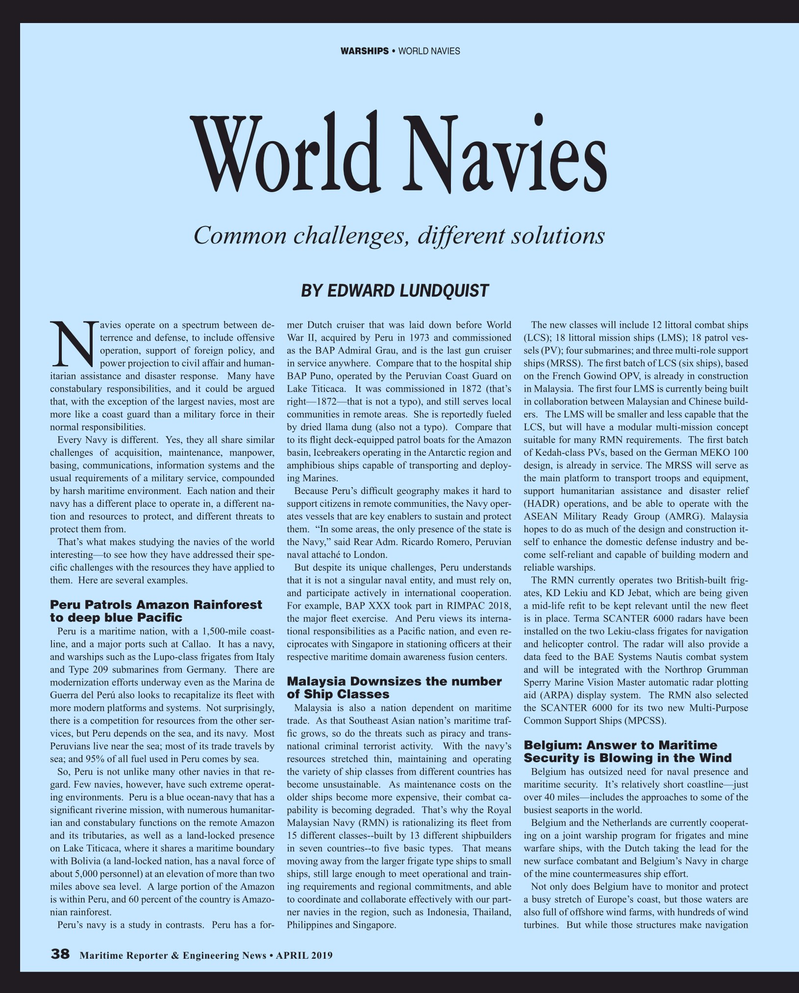
Page 38: of Maritime Reporter Magazine (April 2019)
Navies of the World
Read this page in Pdf, Flash or Html5 edition of April 2019 Maritime Reporter Magazine
WARSHIPS • WORLD NAVIES
World Navies
Common challenges, different solutions
BY EDWARD LUNDQUIST avies operate on a spectrum between de- mer Dutch cruiser that was laid down before World The new classes will include 12 littoral combat ships terrence and defense, to include offensive War II, acquired by Peru in 1973 and commissioned (LCS); 18 littoral mission ships (LMS); 18 patrol ves- operation, support of foreign policy, and as the BAP Admiral Grau, and is the last gun cruiser sels (PV); four submarines; and three multi-role support
Npower projection to civil affair and human- in service anywhere. Compare that to the hospital ship ships (MRSS). The ? rst batch of LCS (six ships), based itarian assistance and disaster response. Many have BAP Puno, operated by the Peruvian Coast Guard on on the French Gowind OPV, is already in construction constabulary responsibilities, and it could be argued Lake Titicaca. It was commissioned in 1872 (that’s in Malaysia. The ? rst four LMS is currently being built that, with the exception of the largest navies, most are right—1872—that is not a typo), and still serves local in collaboration between Malaysian and Chinese build- more like a coast guard than a military force in their communities in remote areas. She is reportedly fueled ers. The LMS will be smaller and less capable that the normal responsibilities. by dried llama dung (also not a typo). Compare that LCS, but will have a modular multi-mission concept
Every Navy is different. Yes, they all share similar to its ? ight deck-equipped patrol boats for the Amazon suitable for many RMN requirements. The ? rst batch challenges of acquisition, maintenance, manpower, basin, Icebreakers operating in the Antarctic region and of Kedah-class PVs, based on the German MEKO 100 basing, communications, information systems and the amphibious ships capable of transporting and deploy- design, is already in service. The MRSS will serve as usual requirements of a military service, compounded ing Marines. the main platform to transport troops and equipment, by harsh maritime environment. Each nation and their Because Peru’s dif? cult geography makes it hard to support humanitarian assistance and disaster relief navy has a different place to operate in, a different na- support citizens in remote communities, the Navy oper- (HADR) operations, and be able to operate with the tion and resources to protect, and different threats to ates vessels that are key enablers to sustain and protect ASEAN Military Ready Group (AMRG). Malaysia protect them from. them. “In some areas, the only presence of the state is hopes to do as much of the design and construction it-
That’s what makes studying the navies of the world the Navy,” said Rear Adm. Ricardo Romero, Peruvian self to enhance the domestic defense industry and be- interesting—to see how they have addressed their spe- naval attaché to London. come self-reliant and capable of building modern and ci? c challenges with the resources they have applied to But despite its unique challenges, Peru understands reliable warships. them. Here are several examples. that it is not a singular naval entity, and must rely on, The RMN currently operates two British-built frig- and participate actively in international cooperation. ates, KD Lekiu and KD Jebat, which are being given
Peru Patrols Amazon Rainforest
For example, BAP XXX took part in RIMPAC 2018, a mid-life re? t to be kept relevant until the new ? eet the major ? eet exercise. And Peru views its interna- is in place. Terma SCANTER 6000 radars have been to deep blue Paci? c
Peru is a maritime nation, with a 1,500-mile coast- tional responsibilities as a Paci? c nation, and even re- installed on the two Lekiu-class frigates for navigation line, and a major ports such at Callao. It has a navy, ciprocates with Singapore in stationing of? cers at their and helicopter control. The radar will also provide a and warships such as the Lupo-class frigates from Italy respective maritime domain awareness fusion centers. data feed to the BAE Systems Nautis combat system and Type 209 submarines from Germany. There are and will be integrated with the Northrop Grumman
Malaysia Downsizes the number modernization efforts underway even as the Marina de Sperry Marine Vision Master automatic radar plotting
Guerra del Perú also looks to recapitalize its ? eet with aid (ARPA) display system. The RMN also selected of Ship Classes more modern platforms and systems. Not surprisingly, Malaysia is also a nation dependent on maritime the SCANTER 6000 for its two new Multi-Purpose there is a competition for resources from the other ser- trade. As that Southeast Asian nation’s maritime traf- Common Support Ships (MPCSS).
vices, but Peru depends on the sea, and its navy. Most ? c grows, so do the threats such as piracy and trans-
Belgium: Answer to Maritime
Peruvians live near the sea; most of its trade travels by national criminal terrorist activity. With the navy’s sea; and 95% of all fuel used in Peru comes by sea. resources stretched thin, maintaining and operating
Security is Blowing in the Wind
So, Peru is not unlike many other navies in that re- the variety of ship classes from different countries has Belgium has outsized need for naval presence and gard. Few navies, however, have such extreme operat- become unsustainable. As maintenance costs on the maritime security. It’s relatively short coastline—just ing environments. Peru is a blue ocean-navy that has a older ships become more expensive, their combat ca- over 40 miles—includes the approaches to some of the signi? cant riverine mission, with numerous humanitar- pability is becoming degraded. That’s why the Royal busiest seaports in the world.
ian and constabulary functions on the remote Amazon Malaysian Navy (RMN) is rationalizing its ? eet from Belgium and the Netherlands are currently cooperat- and its tributaries, as well as a land-locked presence 15 different classes--built by 13 different shipbuilders ing on a joint warship program for frigates and mine on Lake Titicaca, where it shares a maritime boundary in seven countries--to ? ve basic types. That means warfare ships, with the Dutch taking the lead for the with Bolivia (a land-locked nation, has a naval force of moving away from the larger frigate type ships to small new surface combatant and Belgium’s Navy in charge about 5,000 personnel) at an elevation of more than two ships, still large enough to meet operational and train- of the mine countermeasures ship effort. miles above sea level. A large portion of the Amazon ing requirements and regional commitments, and able Not only does Belgium have to monitor and protect is within Peru, and 60 percent of the country is Amazo- to coordinate and collaborate effectively with our part- a busy stretch of Europe’s coast, but those waters are nian rainforest. ner navies in the region, such as Indonesia, Thailand, also full of offshore wind farms, with hundreds of wind
Peru’s navy is a study in contrasts. Peru has a for- Philippines and Singapore. turbines. But while those structures make navigation 38 Maritime Reporter & Engineering News • APRIL 2019
MR #4 (34-41).indd 38 4/2/2019 12:59:28 PM

 37
37

 39
39
